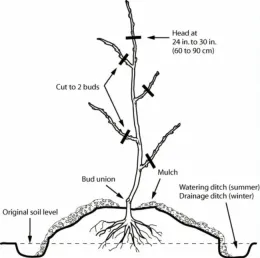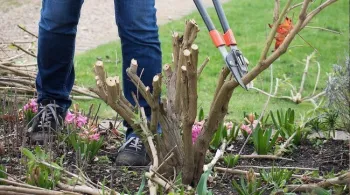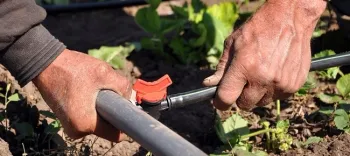Winter Garden Chores
January, February, and March

Just four chores per month, one per week, to consider this wintery season. Hopefully, there are enough pleasant winter days to get them accomplished.
January Ideas
ONE – Plant a bare root rose or fruit tree if there is room in the landscape. If not, pick up a few summer blooming bulbs (such as dahlias, gladiolus, lilies and begonias) and plant them in the ground where they will add color to the landscape or in a pot that can be moved at will.
TWO – Sharpen pruning tools, then dry them and rub them lightly with oil to prevent rust. Don't put them away wet and dirty, which can encourage the formation of rust.
THREE – Prune your roses with those sharp pruners. Vines, fruit and shade trees or grapes will benefit from a good pruning if there are no roses needing a pruning.
FOUR - Rake and discard fallen leaves (a compost pile will enjoy the addition) to prevent or reduce over-wintering pests.
In February:

TWO – Spread some love. Give a small native California plant to a friend, a neighbor, a family member, or yourself. The plant will flourish in our climate and need far less water than other specimens once it reaches maturity
THREE – Start some seeds indoors. Pre-germinate pea seeds on moist paper towels in a warm room for a few days before sowing. See Lee Miller's Winter 2012 or Trish Tremayne's Winter 2015 articles on starting seeds for more information.
FOUR – Feed citrus trees with a nitrogen-rich fertilizer that contains additional nutrients such as Magnesium, Boron, Copper, and Zinc.
March Notes:
ONE – Plant some potatoes. Potatoes can carry soil-borne diseases which are harmless to humans but devastating for a potato plant. Buy seed potatoes from a nursery or a mail-order company that certifies the seed potatoes are disease free. Whole potatoes can be divided to give you a bigger crop by cutting the potatoes into chunks that each contain one or two eyes (the small depression where sprouts will form). To prevent rotting, store the freshly cut pieces at room temperature for three days before planting to allow the cut surfaces to dry and form a callus. Potatoes are heavy feeders, so planting with a good amount of compost will help the plant and your harvest. Potatoes can be heavy producers and harvesting them feels like a “treasure hunt.” This is a fun vegetable for children to plant and harvest.
TWO - Prune suckers (the branches that sprout directly from the root stock beneath the soil) from trees and shrubs.

FOUR – March right into a local nursery to see (and maybe purchase) annuals, vegetables, and perennials that are available now to fill in those bare spots in the landscape.
Information gathered from:
